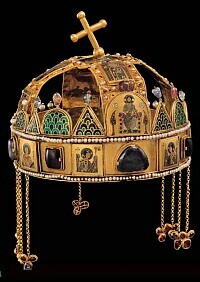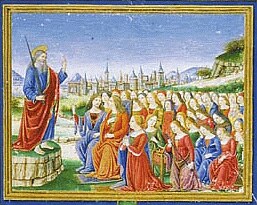
|
To our
respected and
dear guests,
Hungarians joined European
Christian culture one thousand years ago. The adoption of Christianity entailed
a change in our way of life, and the Church played a crucial role in this
adjustment. After converting, the once nomadic, pastoral people built churches
and monasteries, which were decorated by masters from home and abroad and
furnished with beautiful devotional objects crafted by talented artists.
Our country warmly welcomed foreigners: Benedictine, Cistercian, and Franciscan
monks as well as Italian, German, French and Byzantine missionaries, from
whom our people gained knowledge of the Christian beliefs and acquired the
power of faith.
|

|
The
Church not only provided our people with faith, churches, and outstanding
historical figures, but also passed on its comprehensive knowledge to us
and taught us the art of renewal. Enemy forces may have ravaged our country,
but to little effect, for the building of both churches and souls always
followed in the wake of destruction. The Catholic Church is a part of our
everyday lives; this was the case in the past, in the days of persecution,
and today, in a democracy too. Entrusted with the task - as is its mission
- of delivering the good news, the Church has made its presence felt in both
families and society alike. |

|
Our
hope is that this exhibit will provide visitors with a glimpse into the thousand-year
history of a country. Our art bears the marks of a people with a unique culture
while at the same time reflecting the style of the various periods. You,
who have arrived from all parts of the world, whether Catholic or not, will
be able to understand the exhibit without having any knowledge of our language.
As you view our art, you will recognize its symbolic messages, wonder at
its individuality, and discover its similarities to familiar monuments from
other Christian countries. The explanation for this is simple: Christianity
binds us together. The Church provided the most important setting for one
thousand years of interconnections between European and Hungarian art. This
cultural link is proof that our nation will be a worthy companion to those
integrating into the Europe of the future. |

|
To
our respected and dear guests,
As we take this occasion
to express our gratitude to the Vatican Museum for their assistance in making
this exhibit possible, we also invite you to Hungary to see all that we would
have liked to display, but because of our limitations could not. Have a look
at the most important towns of Hungarian Christianity: Esztergom, Kalocsa,
Eger, and Veszprém; make your way up to the abbey of Pannonhalma;
pay a visit to our churches and museums. Be our guest!
Laszlo Cardinal
Paskai
Archbishop of Esztergom-Budapest,
Primate of Hungary
|
![]()